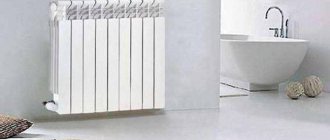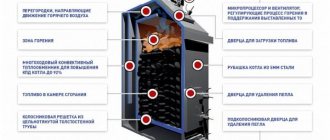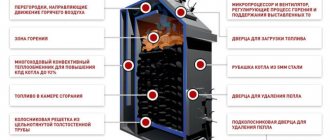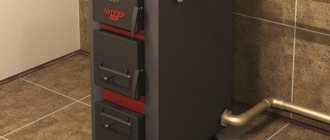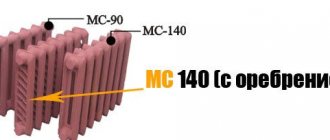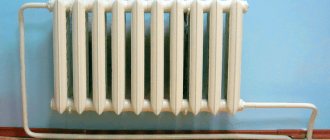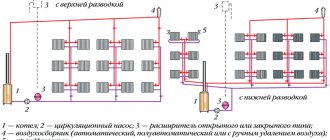With the onset of cold weather, the question of comfortable temperature in homes arises. The main heating network does not always cope with its task and sometimes cannot provide the required temperature conditions, so you have to look for other solutions for heating the room.
Electric radiators are a good addition, and sometimes the main source of heating for a home.
Types of electric heating radiators
Electric radiators for heating are divided into several types. They differ in the method of heat transfer and internal structure.
When visiting specialized departments, you can encounter the following types:
- Fan heater;
- Convector;
- Oil radiator;
- Infrared heater.
To evaluate all the advantages and disadvantages of each device, we recommend that you familiarize yourself with the technical characteristics of each type.
Electric convector or electric radiator?
Electric convector: Currently, electric heaters are becoming increasingly popular among consumers due to their ease of installation and lack of maintenance. service.
MARPE 600 "Powerful" striped infrared film
800 RUR (excl. VAT) m/p
Weight Dimensions width max. power
| 0.3kg |
| 100 × 50 × 0.04 cm |
| 50 cm |
| 600 W/m² |
Quantity MARPE 600 “Powerful” striped infrared filmAdd to cart Quick view Add to wishlist Close
Self-regulating infrared film MARPE Black Heat
Rating 5.00 out of RUB 51,600 (excl. VAT) m/n
Weight Dimensions width max. power
| 0.75kg |
| 100 × 100 × 0.06 cm |
| 100 cm |
| 220 W/m² |
Quantity Self-regulating infrared film MARPE Black Heat Add to cart Quantity is limited. Check availabilityPre-order with 30% discount Quick view Add to wishlist Close
Electric radiator Economy EEE-4/800
RUB 16,600 (excluding VAT)
Weight Dimensions heating area power average consumption
| 10 kg |
| 51 × 13 × 62 cm |
| up to 10 m² |
| 0.8/0.4 kW |
| 0.24 kWh |
Quantity Electric radiator Economy EEE-4/800 Add to cart Quantity is limited. Check availabilityPre-order with 30% discount Quick view Add to wishlist Close
Electric radiator Economy EEE-6/1200
Rating 5.00 out of RUB 519,750 (excluding VAT)
Weight Dimensions heating area power average consumption
| 12 kg |
| 68 × 13 × 62 cm |
| up to 15 m² |
| 1.2/0.6 kW |
| 0.36 kWh |
Quantity Electric radiator Economy EEE-6/1200 Add to cart Quantity is limited. Check availabilityPre-order with 30% discount Quick view Add to wishlist Close
What are fan heaters
Most positive reviews about this type of product claim that such heating devices have good efficiency. The design includes a fan and a heating element.
- The heated air is evenly distributed using a fan around the perimeter of the room.
- The heating elements are made in the form of tubes or spirals. The design includes a thermostat.
- Its operating principle is based on turning off the heater after reaching the desired temperature.
This part is responsible for the rotation speed of the fan blades. Thanks to it, it is possible to prevent overheating of the device during long-term operation.
Types and design of electric heaters
We immediately warn you that we are not talking about traditional heating devices of infrared or convector type. We are considering electric batteries made in the form of ordinary mounted heating radiators (shown in the photo).
Electrical panels are offered in two versions – wall-mounted and floor-mounted
At the moment, online stores offer 4 types of electric radiators:
- sectional heaters of the “dry” type;
- ceramic heating panels;
- vacuum wall radiators using electricity;
- universal vacuum batteries capable of operating from electricity or the classic coolant - water.
In order to draw positive or negative conclusions about the listed heaters, you need to understand their design and operating principle. Plus study the reviews of users who managed to buy and test the operation of electric batteries for heating a private home. Let's look at each product separately.
Liquidless sectional heaters
In appearance, the product resembles a sectional radiator made of aluminum alloy, attached to the wall and designed to work in a water heating system. Only on the sides there are decorative plastic panels, one of which has a built-in control panel with a display.
Heating element heating panels are very similar to bimetallic or aluminum radiators, but have their own control panel and thermostat
The inside of the device looks like this:
- battery sections are cast from an aluminum-silicon alloy (silumin) and equipped with heat exchange fins;
- each section has a built-in tubular heater (TEN) with a power of up to 200 W;
- the elements are twisted together, and the heating elements are connected to the power line in a parallel circuit;
- heating is controlled by a thermostat connected to an electronic unit.
Note. The user sets the required room temperature on the display, and the thermostat maintains it automatically. It is possible to switch to an economical operating mode when half of the heating elements in the electric battery are inactive.
The principle of operation is extremely simple: the device is connected to the network, heating elements heat the finned sections that transfer heat to the room. Since the maximum surface temperature is 80 °C, heat transfer occurs in two ways - infrared radiation and convection (direct heating of the air). The required power is obtained by the number of sections.
Each section is equipped with its own heater, there is no coolant
Now comes the fun part. The price of an electric radiator with a power of 0.8 kW from 4 sections of a standard size of 500 mm, offered by the Russian one, is 210 USD. e. (12.5 thousand rubles as of autumn 2022). For comparison: a convector from the famous European brand Nobo (Nobo) model Oslo NTE4S-10 with a heat output of 1 kW costs 9,200 rubles. or 155 USD e.
Reference. The price of 1 section (500 mm high) of an aluminum Italian Global radiator, which looks similar to an electric battery, is 9 USD. e.
Ceramic panels
These products with a pleasant external design are a “layer cake” of several elements shown in the diagram:
- The front part is a 10-20 mm thick ceramic plate. Usually decorated with a cute design or photo print.
- A heating element is installed behind the stove - a chromium-nickel spiral laid in a snake (another option is a carbon heater).
- At the back of the heating element there is a metal sheet, profiled as an accordion.
- The last part is the protective casing.
Diagram of the internal structure of a ceramic heating panel
There are no revolutionary solutions in the design of a ceramic electrical panel, although the device is quite successful. The spiral heats the front plate and the rear steel sheet to 80-85 ° C, causing the first to radiate infrared heat, and the second heats the air passing along the bends of the profile due to convective circulation. There is a control panel and thermostat.
The power of ceramic electric batteries depends on the size. A 0.6 x 0.6 m panel consumes (respectively, releases into the room) about 350 W, depending on the manufacturer. So that you have an idea about ceramic electric heaters, we suggest watching a short video. Just don’t take seriously the announcer’s words about the wonderful properties of the device.
Another interesting note. The price of a product 1200 x 600 mm at 0.99 kW, comparable in power to the Nobo convector mentioned above, is 15.9 thousand rubles. or almost 270 USD e.
Vacuum radiators
A vapor-drip electric heating battery, also known as a vacuum energy-saving radiator, also known as a liquid mini-boiler, operates on the principle of a closed two-phase gravity-type thermosyphon.? Have you exhaled?
Now let's move on to human language that is understandable to users. The heating device is a sealed chamber (thermosiphon) with evacuated air, into which a certain amount of bromide salt solution is poured. Under the sections there is a second chamber with an air or water heating element with a power of up to 1 kW. The work algorithm is designed like this:
- Once turned on, the tubular element heats the lower chamber.
- Since there is a vacuum in the upper chamber, the liquid begins to boil at a lower temperature (according to manufacturers, from 30 ° C).
- The solution turns into steam, filling the entire vacuum battery. When it comes into contact with cold walls, it gives off heat and condenses, flowing back into the lower zone in drops. Hence the name - vapor-droplet, and the 2 phases are evaporation and condensation of the liquid.
The steam evenly fills the entire body and quickly warms it up.
For reference. The principle of a thermosyphon (simply a heat pipe) involves the transfer of a large amount of heat at the moment of evaporation and condensation of a solution. In this way, it is similar to the operation of an air conditioner, transferring thermal energy from indoors to outdoors and vice versa. Here the transfer is carried out from the heating element to the room air, the mediator is a solution of bromide salt.
As in other electric radiators, the design includes a thermostat that limits the heating of the liquid - the working fluid. Universal vacuum heaters are capable of working with conventional coolant - water supplied from the boiler to the lower chamber. In this case, the heating element is removed. We watch another video and mentally filter the list of incredible parameters of the device.
Well, for the sake of order, we’ll indicate the price. A heater called “closed-type heating device” PKN-3-0.5 for 4 sections, made in Russia, costs 220 USD. e. (13100 rub.). Chinese analogues can be found cheaper.
Advantages and disadvantages of models
A floor-mounted electric radiator has the advantage of being able to maintain a certain temperature over large areas of the room. They provide quick heating of a closed space.
As for the disadvantages, they consist in the consumption of a large amount of electrical energy. Long-term work is accompanied by the combustion of oxygen in a closed space. Fans with a heating coil must not be used in rooms with high humidity.
What to look for when choosing electric radiators?
To choose a wall-mounted electric heater that best suits your needs, it is important to compare the parameters of the room, the stated needs and the capabilities of the equipment.
Video: features of choosing electric heating batteries
DO NOT BUY Radiators Until You See THIS!!!
Parameters that you need to pay attention to when choosing wall-mounted electric radiators:
- Device power. If you choose it incorrectly, it will either be too hot or, on the contrary, cold. The calculation can be done with the help of specialists, using ready-made formulas or an online calculator. For example, for a room with a ceiling height of 3 m, 1 kW of power for every 10 square meters is sufficient. m to obtain an output temperature of +20…+23°С. For regions with harsh winters, the recommended norm is 1.5 kW, for the southern regions - 0.5 kW per 10 sq. m. m.
- Installation method. There are stationary and mobile heaters. Some are hung on vertical structures, others on horizontal structures.
- heating element. Their service life is approximately 15 years. But there are models with longer operating times. Such heaters are more expensive, so they are rarely used for summer cottages.
- Nutrition. Electric wall heaters require a separate power line from the panel. It is recommended to purchase convectors that have an electronic thermostat. They are more sensitive to temperature fluctuations and can change the power of the radiator.
Operating principle of an oil cooler
Oil-filled electric heating radiators must be filled with special mineral oil.
During operation, the heating component gradually increases the temperature of the liquid medium, which releases it through the walls of the housing.
Such devices do not have a spiral or heating flask in the public domain. The device does not burn oxygen and fine dust. What are the advantages of this model? These include:
- Safety;
- Design mobility;
- No noise during operation.
There are disadvantages, which include uneven heating of the enclosed space and increased temperature of the device body. In addition, the models are large in size, which affects their transportation.
Calculation of electricity consumption by an economical convector
Recently, manufacturers have been producing convectors with improved characteristics and call them economical. Whether using them really saves electricity will be shown by calculation.
For example, let’s take a well-insulated room with an area of 15 square meters. m., heated by an economical convector - Noirot with a power of 1500 W. We set the temperature to 20 °C, at an outside temperature of -5 °C.
Convector Noirot Spot-E3
Judging by the manufacturer's data, the room will warm up in 20 minutes. For initial heating the following is used:
0.33x1.5 = 0.5 kWh.
In order for the set temperature to be maintained, it is necessary for the convector to operate for 7 to 10 minutes. In one hour:
0.15x1.5 = 0.225 kWh.
8 hours of operation consumes electricity
0.225x8+0.5 = 2.3 kWh.
If we take into account that in the absence of people you can use the economical mode - from 10 to 12 degrees, the electricity consumption will be:
0.08x1.5x16 = 1.92 kWh.
In total, per day you will spend:
2.3+1.92 = 4.22 kWh.
Since a conventional convector consisting of several elements consumes from 6.8 to 7.5 kWh, then, according to the manufacturer, 2.58 - 3.28 kWh is saved.
Wall models
Wall-mounted electric heating radiators are equipped with a metal body and heating elements. They have a control panel and a timer. The convector does not evaporate moisture from oxygen and does not burn dust particles.
It is distinguished by its safety, easy operation and ultra-precise control, allowing a person to monitor the operation of the device.
- The operating principle of this device is based on the circulation of air masses.
- Cold air sinks down, and warm air slowly rises to the top.
- The cycle will repeat continuously unless the control panel is switched.
The only drawback of such a device is the lack of area for its mounting. Most models are distinguished by their impressive dimensions, which may not fit into the overall interior.
Wall-mounted oil batteries: the worst?
We have included oil batteries in this list only to protect you from these heaters. We believe that such electrical appliances cannot even stand on a par with those listed above for some reasons that we know from practice:
- Fire hazardous
- Not reliable
- Can't stand intense work
You may think that we are wrong. After all, many of you have such heaters, and many of you have never failed, and some of you will say: “Yes, I have had such a battery in my dacha for 10 years and it still works!” And everything you say will be true, but only from a subjective point of view.
From an objective point of view, the majority of fires caused by electric heaters are oil heaters.
Their housing is often subject to depressurization and oil leakage. As soon as the oil level drops below the heating element and exposes it, it begins to reach a fire-hazardous temperature, and there is a danger of the oil catching fire.
Therefore, such heaters cannot be left unattended, much less used as the main heating. But in defense of these models, we can say that they really heat well, since they have numerous sections and heat primarily by convection.
If you decide to buy an oil heater, we recommend using it as additional heat for your room and only under human supervision.
Pros:
- Low price
- Heats the room quickly
- Mobility (usually used with wheels on legs)
Minuses:
- Fire hazardous
- Unreliable
- Human supervision required
- Consumes a lot
- Not suitable as main heating
Description of infrared models
We recommend that you familiarize yourself with another type of electric radiator. Infrared models are considered new and high-quality products. The heater slowly heats the air masses inside the room.
Infrared rays help heat the surfaces of all objects that are in space. Manufacturers achieved this effect using electromagnetic waves that appear at a certain frequency.
During operation, the infrared radiator has a cold surface. The design includes shutdown sensors and a thermostat. Thanks to these details, the device is considered safe for independent use.
The advantages of such products are their simple installation and safe connection to the electrical network. Professionals claim that such models can provide rapid heating of air masses in a closed space and maintain it for 3 hours.
Thanks to several devices, it is possible to create a comfortable temperature in different parts of the room.
What are considered disadvantages? These include:
- Slow heating of the space;
- Cannot be used in rooms with high ceilings;
- It is regularly necessary to create a distance from the heating device to surrounding objects. The fact is that some surfaces can ignite when exposed to infrared rays;
- Price. The price for an electric heating radiator of this model is quite high.
How to make an electric battery yourself
If you are interested in organizing heating that is simple and inexpensive to install, make an electric battery with your own hands from an old cast-iron radiator. What you need to buy:
- Heating element with a power of 0.3-0.8 kW with a water thermostat;
- 2 end caps with gaskets;
- futorka with Mayevsky tap;
- room thermostat;
- wires with a cross section of 2.5 mm².
Note. Select the tubular electric heater according to the length of the radiator - the element must pass through all sections.
Assembling the electric battery is simple: install a heating element in the lower hole of the outer section, lubricating the gasket with high-temperature sealant. Screw the fitting into the opposite upper hole, open the Mayevsky tap slightly. Close the remaining side holes with plugs and fill the battery with water.
Connect the water thermostat, setting the maximum temperature to 80 °C to avoid boiling. Install a room thermostat and connect it with wires to the heating element. For details on how to make an electric battery, watch the next video:
Advantages of aluminum radiators
Recently, aluminum models of heating radiators have become in demand and popular. Thanks to them, it is possible to save electrical energy.
- They calmly react to changes in electrical voltage and are able to form an energy-saving autonomous unit.
- As for heat transfer, its level is three times higher than that of a cast iron and steel model.
- This criterion is associated with good thermal conductivity and an aluminum base.
They are ideal for spacious and small spaces. Equipment of this type consumes a minimal amount of electricity.
What is the best way to choose a radiator for a specific room?
On average, the rated power of one section is 0.13 kW. The required number of sections is selected depending on the area of the room according to Table 1. The data presented in the table is relevant for city apartments located in an insulated apartment building. If the room is located on the corner of the building, or the house is poorly insulated, the recommended number of sections should be looked at 1-2 lines below the specified area of the room.
Table 1 - Selection of an electric radiator depending on the area of the room
| Room area, m2 | Recommended number of sections | Rated power, kW | Electricity consumption, kW/hour |
| less than 4 | 3 | 0,39 | 0,10 |
| from 4 to 6 | 4 | 0,52 | 0,15 |
| from 6 to 8 | 5 | 0,65 | 0,20 |
| from 8 to 10 | 6 | 0,78 | 0,25 |
| from 10 to 12 | 7 | 0,91 | 0,30 |
| from 12 to 14 | 8 | 1,04 | 0,35 |
| from 14 to 16 | 9 | 1,17 | 0,40 |
| from 16 to 18 | 10 | 1,30 | 0,45 |
| from 18 to 20 | 11 | 1,43 | 0,50 |
| from 20 to 22 | 12 | 1,56 | 0,55 |
If the area of the room exceeds 22 meters, heating it requires the installation of two or three radiators. It is also recommended to increase the number of radiators if there is more than one window in the room. In this case, heating devices installed under each window create a thermal curtain, reducing the outflow of heat outside the room.
Photos of electric heating radiators
Energy-saving electric radiators TERI
Let's consider another example when manufacturers' statements do not correspond to reality - TERI electric radiators, which, one might say, deceived physics. On their website we see the following:
As it was written earlier: the law of conservation of energy cannot be deceived; how much energy a device consumes, so much it releases. That is, if one section of an electric radiator consumes 75 W, then it will output 75 W. What is promised in this passage is absolutely impossible .
The same site provides a comparison of electricity consumption by various power systems:
It is worth noting that the graph is very strange and completely incomprehensible. At the top it is indicated that the heating operates 9 hours a day with a power of 2.07 kW, which means it supposedly spends 1490 kW per month - are these figures given only for the TERI system or for all of the listed systems? If 1490 kW per month is enough to heat a house with a TERI system, then why should other systems spend more? After all, the house is the same.
With the same power, all these types of electrical equipment will consume approximately the same amount of energy. It turns out very interestingly that when using gas heating, costs are higher than when using an electric boiler and electric convector. In fact, 1 kW of heat obtained by burning gas costs 50 kopecks ; 1 kW of heat received from electricity is obtained by spending 1 kW of electricity , and nothing else, which equals 4 rubles according to the tariff . That is, electric heating is always 8 times more expensive than gas heating.
Power calculation and safety rules
The most important parameter when choosing an electric radiator is power. Knowing its value, you can calculate the required number of radiators for each room separately and for the entire house. And the total power indicators will help determine the full amount of heating costs.
Here is the simplest calculation of power. To heat a room of 20 m2, a heater power of 1.5-2.00 kW is required. Therefore, for a house with a total area of 100 m2, you will need five heaters with a total power of 10 kilowatts. But this calculation is approximate. For a more accurate calculation, you need to take into account many factors, such as:
- thermal conductivity of floor, wall and ceiling materials;
- the presence of heat leakage paths (doors, open windows, ventilation ducts);
- requirements for the desired temperature value;
- type of device, methods of thermoregulation and connection used in it;
- power supply parameters.
Also, here are some general tips that apply to electric heating equipment:
- When choosing a convector equipped with an electronic thermostat, preference should be given to well-known brands that have proven themselves - this will be a kind of guarantee of the durability of electrical heating equipment.
- It is necessary to comply with the manufacturers' requirements when installing a radiator - the nearest socket must be located at a distance of at least 10 cm from it, and at the bottom or side, and not at the top.
- The power supply cable must not be allowed to come into contact with the convector body; the distance between the wall and the heating device in a stationary installation should not be less than 5 mm.
- It is forbidden to cover the upper grill of the convector with any things - it will not be possible to dry them on this device, since overheating will immediately activate the emergency shutdown sensor.
For the correct selection and installation of electrical heating equipment, it is better to consult with a specialist - this will help create an effective and safe system.
Features of calculating the required power of the unit
Electric batteries for a summer residence are the most optimal if there is no gas main pipe nearby, and solid fuel is difficult to obtain or is expensive. However, first you need to determine how many devices need to be installed to make the house warm and cozy. This is quite easy to do.
For example, if you need to heat a room whose area is about 20 square meters, then the thermal power of the battery should be approximately 1.5-1.6 kW. However, here it is also advisable to take into account the presence of old windows, gaps or cracks in the walls, ceiling, and doors. This can increase energy consumption by up to 2.5 kW.
Thus, it can be assumed that such a heating device can be most effective and economical in those rooms that are well insulated. Please note that the amount of thermal radiation of one section is about 150 W. If your room requires 1600 W of power, then you will need at least 11 sections.
During the calculation, it is also necessary to take into account the surface area of thermal radiation and the presence of defects through which heat loss occurs.
Electric radiators for heating a home: to use or not?
If you decide to buy an electric radiator for your main heating, remember: heating with electricity is expensive . More expensive than heating with gas, coal, wood, diesel, waste oils. No matter what electrical equipment you choose, your energy bills will be significant.
But as an additional heat source, an electric radiator is quite suitable. But don’t rush to believe what some manufacturers write about their equipment. Remember, as much as the device consumes, it will return as much. And if low power consumption is promised, it means there will be little heat from the device .
Often, when you buy an energy-saving appliance, you pay for marketing fairy tales. Take, for example, the same TERI electric radiators.
For a power of 900 W you will pay 19,000 rubles , while an ordinary electric convector with a power of 900 W can be bought for 2000-4000 rubles . At the same time, they will work the same and give off the same heat. The difference is noticeable.
If you have not found the answer to your question, please leave it in the comments below the article - and we will definitely answer you.



